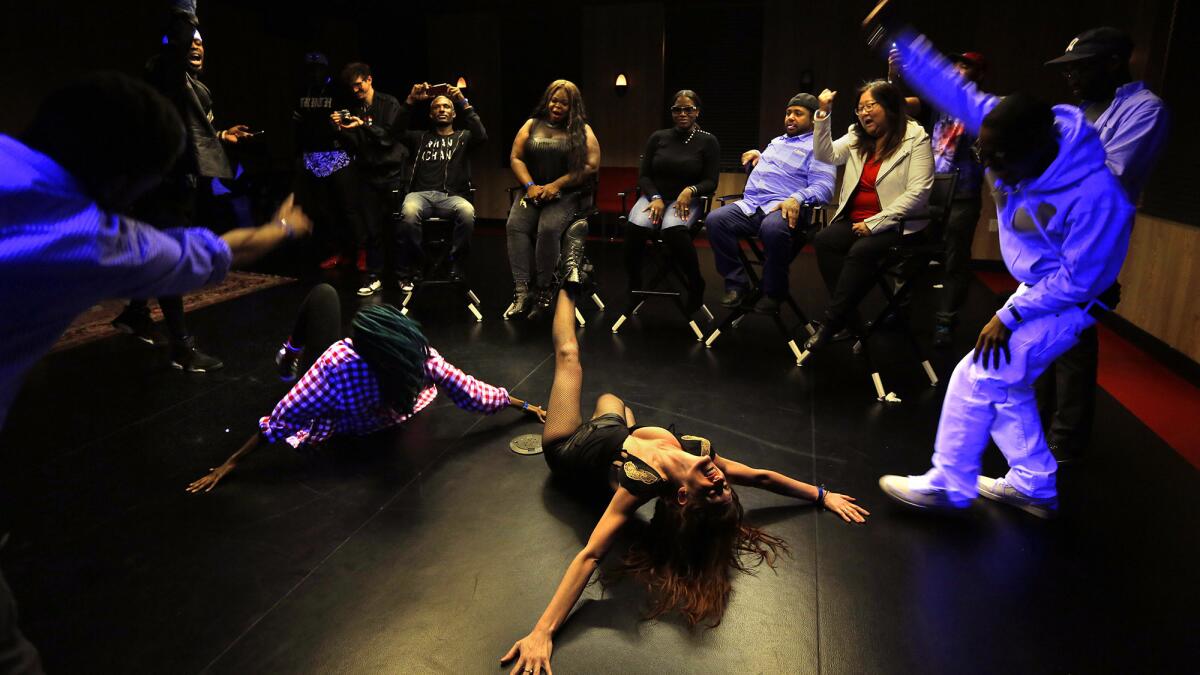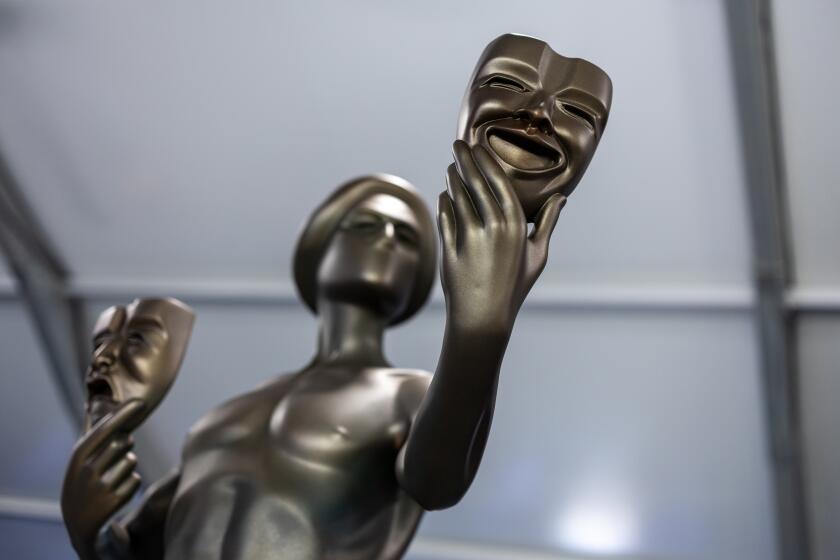Inside the underground world of ballroom at downtown L.A.’s Banjee Ball

Dolores Ninja Parisi strikes a final pose while competing in the vogue performance during the Banjee Ball at the Standard hotel.
- Share via
Strutting from the back of a long, blacklighted room, two gay men try their best model walk. On the tips of their toes, as if they have on heels, they pump their legs to the beat of the music in front of a panel of five judges. Behind them a crowd of about 50 forms a half-circle belting out affirmations, while commentator Enyce Chanel yells over the speakers.
“I want to be Naomi,” he says, invoking the name of a model they should emulate. Then a new idol to imitate: “I want to be Miss Banks.”
When the models get to the end of the faux catwalk, they pose, staring each judge in the eyes. They strut up and down once more, and Chanel sounds off again.
“One, two, three, and hold that pose for me,” he says, instructing the models to stop, matching the staccato beat of the music.
The judges give one competitor his “10s,” and the other gets a “chop” — a subtle head shake or cutting hand motion across the neck.
Just past midnight on a Friday every month, the Banjee Ball at the Standard hotel in downtown L.A. is where two worlds collide: hipsters who’ve stumbled into their latest alternative scene, and gay and transgender men and women carrying on the legacy of their elders in the ballroom community.
But here, you won’t see your grandmother’s waltz.
The underground world of ballroom first surfaced in popular culture with the 1990 documentary “Paris Is Burning.” Twenty-five years later, despite gay marriage being legalized in a growing number of states and TV shows like “Transparent” and “Orange Is the New Black” featuring transgender characters, ballroom still serves as a place of acceptance for participants who find themselves otherwise marginalized.
Most are black or Latino, and they “walk,” or compete, at events known as balls. Many belong to cliques known as “houses.” Led by a mother or father figure, houses serve as families for their members, some of whom have cut ties with their biological kin.
As Chanel puts it, “I joined a house because these are the people that will have my back. Because I don’t have my family.”
Some houses are named after fashion designers such as Chanel or Balenciaga. Others carry the name of a legend in the community, like Willi Ninja or Pepper LaBeija.
The categories include “runway,” where participants strut their stuff like high-fashion models, and “realness,” which dates to an era when blending in as heterosexual was necessary. The vastness of the categories — for “butch queens,” “femme queens” and more — provides space for those who blur the lines of sex and gender.
Perhaps the most well-known category is vogue performance, the dance of complex hand gestures, contorted body poses and dramatic dips and flips. Most will recall Madonna’s single from the ‘90s, but before her, Malcolm McLaren paid homage to the houses of ballroom with his song “Deep in Vogue” featuring Ninja, the godfather of voguing. Contemporary artists such as Beyoncé, Azealia Banks and Willow Smith have also featured elements of voguing in their music and videos.
Supportive space
At the core of ballroom is an innate longing to be accepted. Many who participate were kicked out of their homes by anti-gay parents or aged out of the foster care system, leaving them without support.
Greg Wilson, who used to compete in balls in the house of Ultra Omni, is now deputy director for Reach L.A., a community health organization for black and Latino LGBT youth that provides practice and meeting space (as well as HIV and STD testing). He says ballroom fills a void.
Imagine, he says, feeling like you don’t belong or nobody likes you but then finding a subculture that validates you and says your differences have value. “That’s where the categories and the balls come in,” he says.
Sean Milan Garcon, a former ballroom competitor who also works at Reach L.A., helps the organization put together competitions, the biggest of which is the Ovahness Ball held every fall. The event draws several hundred and easily is one of the largest in Los Angeles.
The monthly Banjee Ball at the Standard may be the most consistently held local event, Milan Garcon says, but it’s not the most authentic portrayal of ballroom. The event captures the glamour and fun atmosphere but is missing the “hunger and yearning for acceptance, appreciation, love and understanding.” He likens it to “ballroom preschool.”
“It’s a great thing because it does introduce people to what ballroom is,” Milan Garcon says, “but at the same time, it doesn’t quite fully give people the essence.”
Isla Cheadle, founder and host of the Banjee Ball, agrees that the event isn’t “hard core” but says it has become an important place where different communities come together to bridge their differences.
“You would think that the downtown L.A. community, which is multicultural, would be immersed with the ball community, but it’s actually completely separated,” she said, pointing out that without the balls, the Latino hipsters and fashionistas of downtown likely wouldn’t interact with the black ballroom aficionados.
Cheadle, a newly minted member of the house of Chanel, is a prime example. A straight white woman, she forms half of the self-described “hetero-married queer indie-pop” group Purple Crush with her husband, Jared Selter.
“This has always been the community that accepts me artistically more than any other,” she said. “The gay community is my home.”
The scene serves as a creative outlet for people to display their talent, but Chanel says ballroom also helps to build strength and confidence.
“You cannot be weak and try to be in this world,” he said.
Generation shift
Even as individuals grow stronger, the Los Angeles scene as a whole is in decline, Chanel says.
He sees a generational shift in ball kids. The unity and fun that come with competition against other houses are not necessarily paramount anymore. In-house rivalries and jealousy are more prevalent.
“This new generation of kids doesn’t know how to be in a house,” he says.
Now the scene is full of people seeking fame, even if only on a local level. Rather than push their careers further outside the safe world of ballroom, Milan Garcon says, they settle for the modest celebrity that they can achieve within the community.
“Ballroom is often used as an excuse for minor success for those who do not believe they can be any more successful than society is telling them they can be,” he says. “It’s easier to go to a ball and be famous than say, ‘I have talent and I’m going to be this great choreographer.’”
Chanel worries the scene is slipping into a coma, but for now the Banjee Ball remains the ever-so-slight heartbeat keeping a tradition alive. Though it is a “cute, kind of foo-foo” version of ballroom for a more mainstream crowd, Milan Garcon says, that does have its benefits.
“It helps the kids see that others are interested in the art they possess,” he says.
More than anything, Wilson says, ballroom remains an act of defiance against a world that still often looks down on people for being different.
As people who have long felt like they don’t belong or are not accepted, they can attend a ball and “be a part of families that say, ‘We love you for who you are,’” Wilson says. “That’s the benefit of being a ball kid.”
More to Read
The biggest entertainment stories
Get our big stories about Hollywood, film, television, music, arts, culture and more right in your inbox as soon as they publish.
You may occasionally receive promotional content from the Los Angeles Times.











